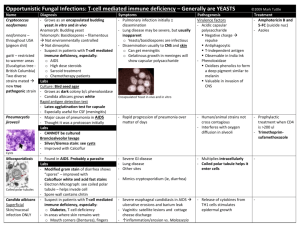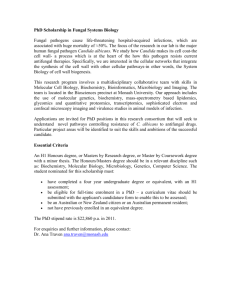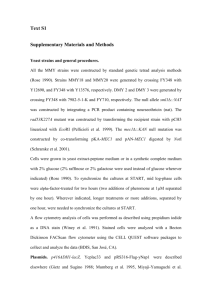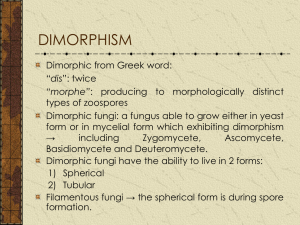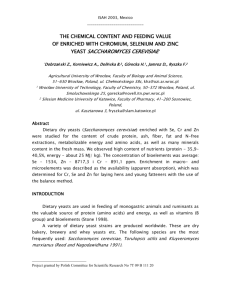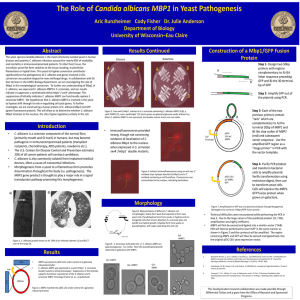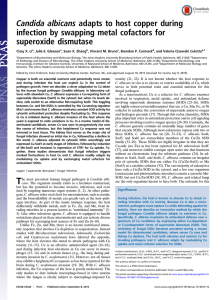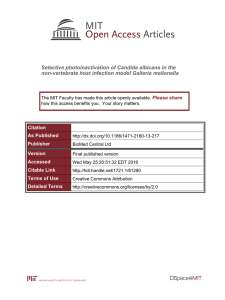Laboratory Exercise # 15: Yeasts and Molds
advertisement
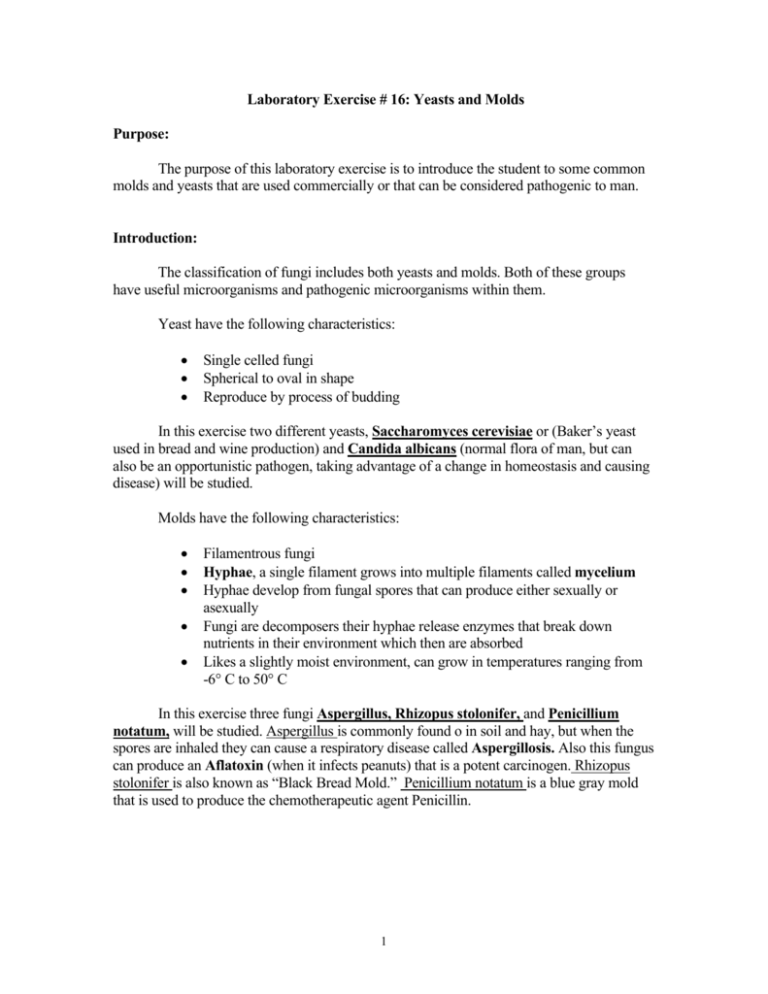
Laboratory Exercise # 16: Yeasts and Molds Purpose: The purpose of this laboratory exercise is to introduce the student to some common molds and yeasts that are used commercially or that can be considered pathogenic to man. Introduction: The classification of fungi includes both yeasts and molds. Both of these groups have useful microorganisms and pathogenic microorganisms within them. Yeast have the following characteristics: • • • Single celled fungi Spherical to oval in shape Reproduce by process of budding In this exercise two different yeasts, Saccharomyces cerevisiae or (Baker’s yeast used in bread and wine production) and Candida albicans (normal flora of man, but can also be an opportunistic pathogen, taking advantage of a change in homeostasis and causing disease) will be studied. Molds have the following characteristics: • • • • • Filamentrous fungi Hyphae, a single filament grows into multiple filaments called mycelium Hyphae develop from fungal spores that can produce either sexually or asexually Fungi are decomposers their hyphae release enzymes that break down nutrients in their environment which then are absorbed Likes a slightly moist environment, can grow in temperatures ranging from -6° C to 50° C In this exercise three fungi Aspergillus, Rhizopus stolonifer, and Penicillium notatum, will be studied. Aspergillus is commonly found o in soil and hay, but when the spores are inhaled they can cause a respiratory disease called Aspergillosis. Also this fungus can produce an Aflatoxin (when it infects peanuts) that is a potent carcinogen. Rhizopus stolonifer is also known as “Black Bread Mold.” Penicillium notatum is a blue gray mold that is used to produce the chemotherapeutic agent Penicillin. 1 Materials: Prepared slides of: Aspergillus condia Penicillium condia Rhizopus condia Sabouraud dextrose agar plates of: Candida albicans Saccharomyces cerevisiae Purchased plates of: Penicillium notatum Aspergillus Rhizopus Rabbit plasma cultures of: Candida albicans Saccharomyces cerevisiae Procedure: This laboratory is a demonstration laboratory. The student is responsible for observing all of the different cultures and slides on display. PLEASE DO NOT REMOVE THE LIDS OF THE MOLD PETRI DISHES!! The spores of the mold are easily dispersed by simple air flow and they then can contaminate the lab room. 1. Observe Candida albicans and Saccharomyces cerevisiae on Sabouraud Dextrose agar. Describe the colonial morphology of each yeast on the data page. 2. Make gram stains of Candida albicans and Saccharomyces cerevisiae. Record observations on the data sheet. 3. Observe the slides of rabbit plasma containing Candida albicans and Saccharomyces cerevisiae. These three hour cultures are used to promote the production of germ tubes. Make a sketch of both slides on the data sheet. 4. Using a dissecting microscope, observe the plates of Penicillium, Aspergillus, and Rhizopus. REMEMBER DO NOT OPEN THE LIDS!! Note the colony pigmentation and record the appearance (rhizoidal for Rhizopus and filamentrous for Aspergillus and Penicillium). 2 5. Observe the prepared slides of the above three molds using 10X magnification. Note the sporulating structures. Record your observations on the data sheet. Data: 1. Describe the colonial morphology of Candida albicans and Saccharomyces cerevisiae on Sabouraud dextrose agar. Candida albicans _____________________________________________________ Saccharomyces cerevisiae _____________________________________________ 2. Sketch the gram stains of the two yeasts. C. albicans S. cerevisiae Is there any difference in the gram stain of these two yeasts?_______________________________________ 3. Make a sketch of your observations of Candida albicans and Saccharomyces cerevisiae in rabbit plasma. Which of the two cultures forms a germ tube? _______________________ S. cerevisiae C. albicans 4. How would you be able to determine definitely which of these two yeast you were dealing with? ________________________________________________ 3 5. Describe the colonial morphology of each mold and make a drawing of your microscopic observations of each of the molds. Penicillium Colonial morphology: Pigment :____________________ Form: ______________________ Microscopic Observations of Sporulating Structures (Prepared slide) Aspergillus Colonial morphology: Pigment: ______________________ Form: ________________________ Microscopic Observations of Sporulating Structures (Prepared slide) Rhizopus Colonial Morphology: Pigment: _____________________ Form: _______________________ Microscopic Observations of Sporulating Structures (Prepared slide) Asexual Reproduction Sexually Reproduction 4 Questions: 1. Which of the two genera of yeast studied in lab is used commercially? 2. What sense can you easily use to determine if yeast is present on the culture plate? 3. How can you tell the difference between Saccharomyces and Candida since their gram stains look identical? 4. Which of the molds you observed in lab has the ability to put “roots” down into the agar. 5. Describe in words the sporulating structures of Aspergillus, Penicillium and Rhizopus. 5



